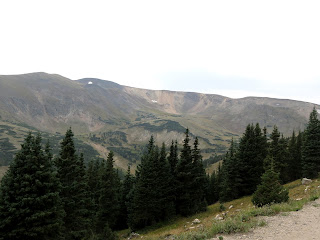Monday, August 20, 2012
Each morning as we left our place going toward Estes Park, this tall Indian Brave would bid us a good day.
There is no way to capture the way that this narrow rocky canyon messes with your senses as you drive through. There are so many colors, textures, and dimensions to the rock, lots of very tight curves and the river switches from one side of the road to the other...it could give one vertigo! I don't think I would ever tire of it.
Throughout the Rockies in this area are various species of mature trees which have grown through tiny, dirt-filled cracks in the rock.
We stopped along the Big Thompson River just to see if "anyone is home" and Rich claimed to have seen one "this big!" ...yeah, right!
While Rich looked for trout, I took photos of wildflowers. Aren't these beautiful?
Another view of "my" river flowing through "my" canyon!
Here we are at the Fall River Entrance Station.
Upon entering the park, we were immediately greeted by several magpies. They are common birds in RMNP.
Looking from Sheep Lakes Meadow up toward Fall River canyon.
Notice the gray area on the lower part of the white trunks of the Aspen trees. Elk eat the more tender inner bark and bulls rub their antlers on the trunks, which removes the outer white bark. There are large elk herds in this park so you see lots of damage to the Aspens, but it doesn't kill them.
Soon enough we came to this sign. Of course we took the high road...meaning the one lane, narrow, dirt road with lots of switchbacks! We do love this kind of adventure.
You can see here where the pavement ends and the dirt road winds upward ahead.
The road twists and turns and drops off sharply, even on the more level stretches.
Oh yeah...here you can see how sharply the road drops off to the side...yikes! Is it obvious that I trust this man with my very life?
We stopped here to listen and look at the lovely Fall River as it tumbled over the rocks alongside the road.
At this turnout, we looked down upon the road we had just driven on and across to the valley below.
The road now runs along the top of the tree line, which is around 10,600 ft.
Alpine tundra is the area above treeline and more than one-third of RMNP is alpine tundra.
Tall posts like these line the road as you approach the Visitor Center and surround all of the buildings so that the location is known when they begin to plow the snow in spring. Summer is brief with only about 40 frost-free days a year; winter winds can exceed 150 miles per hour so the fact that plants survive in this biosphere is miraculous.
Between the Visitor Center and the Gift Shop/Restaurant is a deck overlooking this Glacial Cirque which was the birthplace of many glaciers. As the glaciers receded, this bowl-shaped cirque was carved.
Leaving the Visitor Center on Hwy 34, we stopped to view the tundra with the mountains in the background.
At that overlook, this Wyoming Ground Squirrel seemed to be posing for photos so I finally obliged.
The Alpine Visitor Center sits at 11,796 feet and leaving there on the highway, you continue to climb. The highest point on the road is 12,183 feet...it's hard to breathe at these elevations.
Around every curve, you gasp in wonder at the ever-changing view.
People were parking on the shoulder here and getting out of their cars so we did too. These rocks are home to many Yellow-Bellied Marmots and they were clambering all over these rocks!
These were quite different in appearance and behavior from the ones I watched at Medicine Wheel that day. They are so fat, which they must be to survive the coming harsh winter, and they were silent, not one peep which is unusual for marmots.
See what I mean about the changing scenes?
While standing at this next overlook, in awe of the valley below with a narrow ribbon of river winding through it, I caught one shot of this pika on the rocks in front of me as he turned away.
The landscape continues to change as we descend to lower elevations.
I had mentioned the harsh winter conditions; they change the shape of trees into fascinating shapes and often expose the root systems.
This shot, I just kinda like the fish-eye effect of these trees even though it was not taken with the fish-eye setting.
The mountains above us again as we approach the town of Estes Park.
This formation is called Twin Owls; the Owls watch over the town of Estes Park.
The Girls were with us all day while we drove through the RMNP but I didn't get even one photo of them. When Rich had them outside for a drink and a walk, I was still in the Visitor Center.
Lovin' Life ~~ And National Parks



































No comments:
Post a Comment
Please leave a comment, I love reading them!